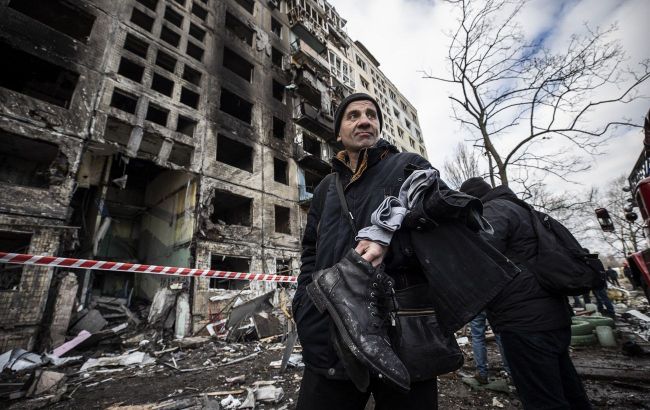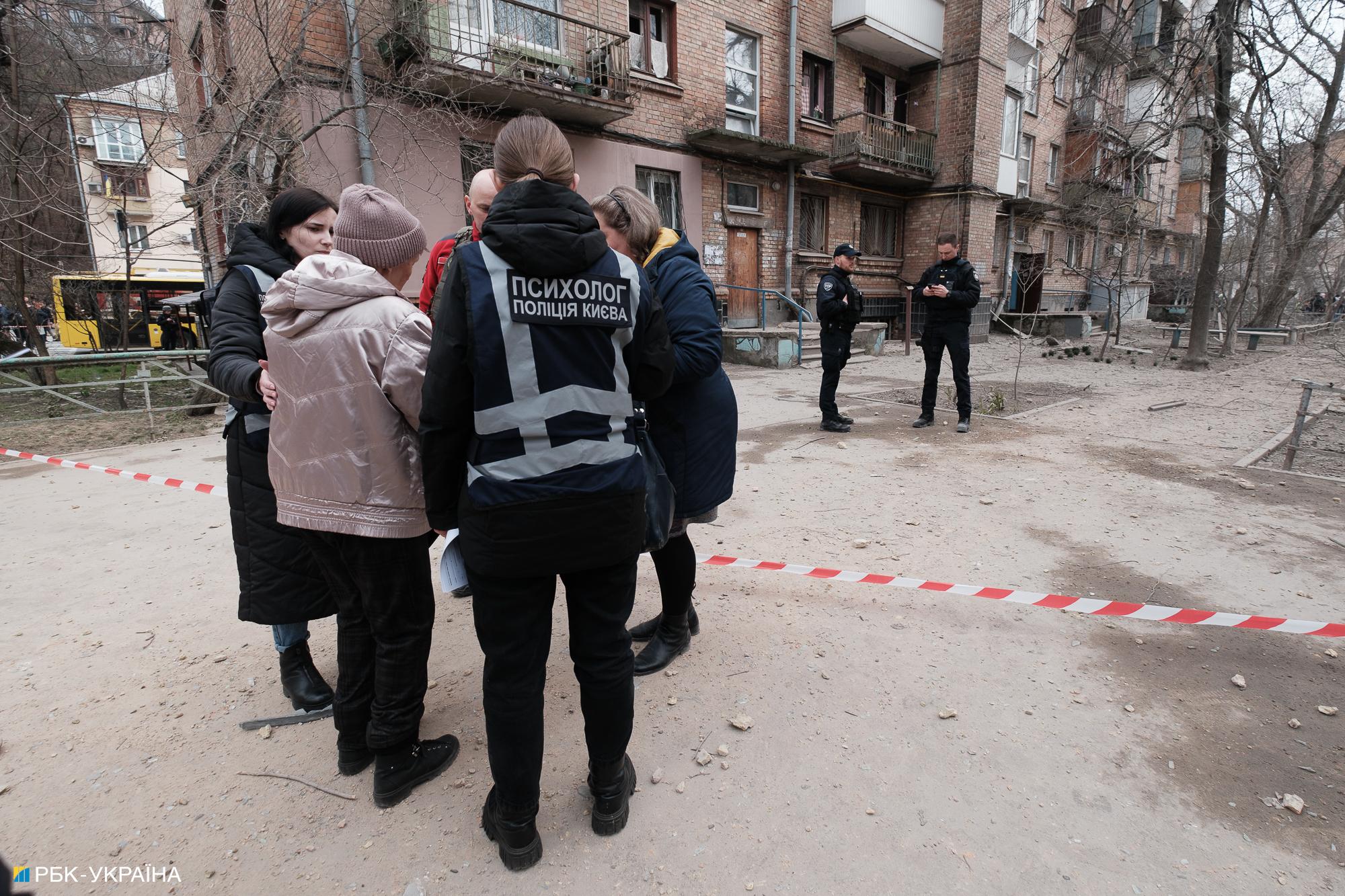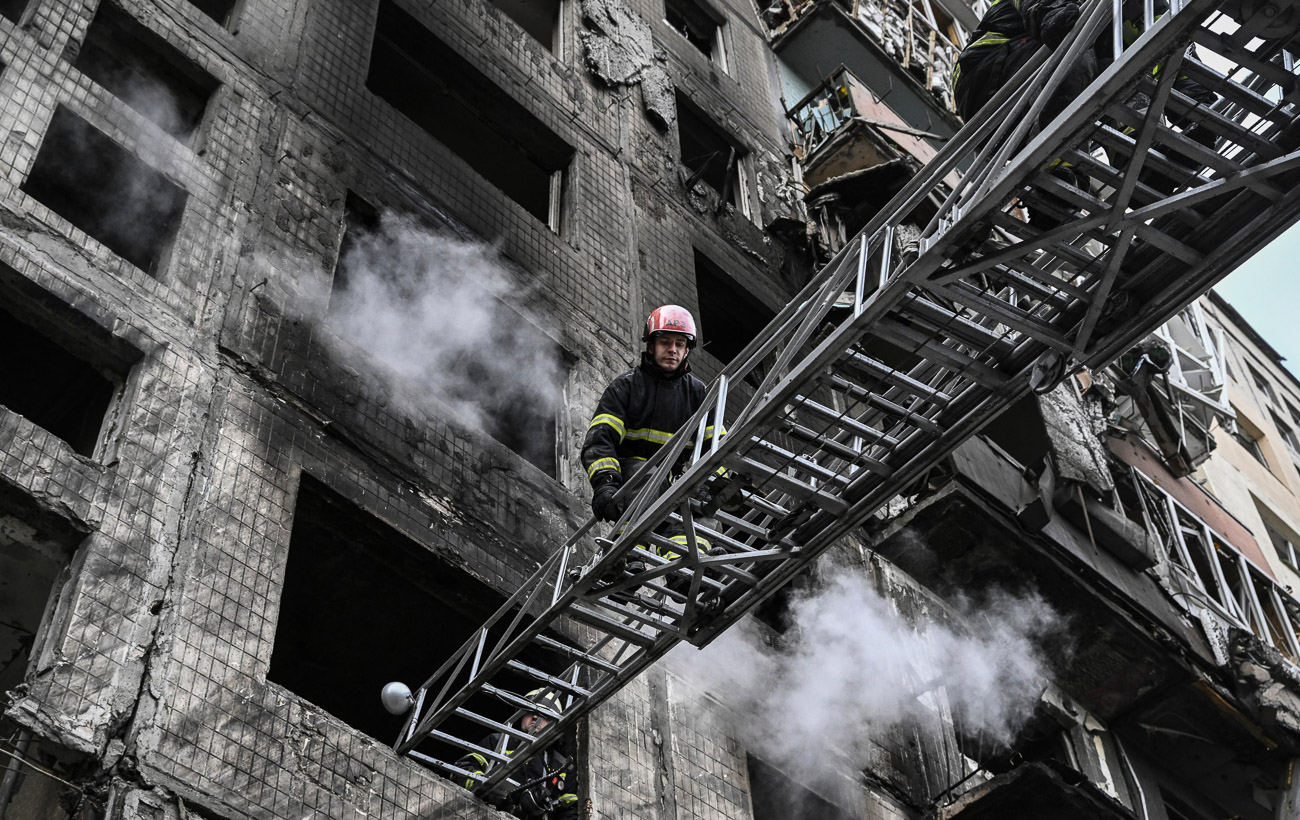Pushing into peace? Why Russia steps up strikes as Putin 'prepares' for negotiations
 The aftermath of the enemy shelling in the Obolonskyi district in Kyiv (photo: Getty Images)
The aftermath of the enemy shelling in the Obolonskyi district in Kyiv (photo: Getty Images)
Russia has drastically increased the scale and frequency of strikes on Ukraine, read in the RBC-Ukraine article what is Moscow's current goal.
Russia has sharply intensified its strikes on Ukraine. While over the past month, the enemy typically launched between 100–200 long-range UAVs per attack on Ukraine's regions, in recent days Moscow has carried out massive combined strikes every night.
This is happening against the backdrop of Russian statements about their willingness to negotiate and end the war. However, the increased intensity of their attacks and the terrorist consequences of these strikes suggest that, in reality, Putin is pursuing other objectives.
Russia's new plan
Throughout the years of the full-scale war, Russia has constantly tried to set peculiar records, competing with itself - firing more missiles, downing a number of Western jets that the Ukrainian Air Force simply doesn't have, and so on.
Over the past three days, the enemy has struck Ukrainian cities each night with missiles and drones. On the night of May 25–26, the Russians sent a record number of long-range UAVs 355, breaking their previous record the night before, when they launched 298 drones.
Nightly attacks by Russian drones, unfortunately, have long become routine for Ukrainians, as they have occurred almost daily since September. The only exceptions were days when Russian President Vladimir Putin announced a truce. Meanwhile, from the beginning of the year until May 24, massive combined strikes with missile weapons were carried out by the enemy about once or twice a month.
On the night of May 23–24, Russian troops struck Ukraine with 14 Iskander-M/KN-23 ballistic missiles. In addition, 250 UAVs were launched at Ukrainian cities, of which the Ukrainian Air Force eliminated 245. Most of them, about 200 drones and 9 Iskander-M/KN-23 ballistic missiles, were targeted at the Ukrainian capital, with explosions and destruction recorded in nearly all districts.
 Consequences of a drone attack in the Sviatoshynskyi district (photo: Vitalii Nosach/RBC-Ukraine)
Consequences of a drone attack in the Sviatoshynskyi district (photo: Vitalii Nosach/RBC-Ukraine)
From May 24 to 25, the pattern was similar - starting in the evening, the Russians launched waves of UAVs, totaling 298, with 266 downed. Later at night, the enemy began launching missiles. This time, the emphasis was on cruise missiles - there were 55 of them (Kalibr and Kh-101), one supersonic anti-ship missile Kh-22, nine Iskander-M/KN-23 ballistic missiles, and four guided air missiles Kh-59/69. On the night of May 25–26, simultaneously with the 355 UAVs, Russian forces launched nine Kh-101s from strategic aviation aircraft.
At the same time, the Russians are not only experimenting with combinations of strike means but also changing UAV launch tactics, in an attempt to bypass Ukrainian air defense and hit targets.
"The current Russian tactic boils down to constantly changing UAV routes and trying to launch them at high altitudes - over 2 kilometers above the ground, then they dive straight down at the target. At such altitudes, they are more visible to our radars but out of reach of small arms, heavy machine guns, and mobile fire groups," explains Yurii Ihnat, Head of communications for the Air Force Command of the Armed Forces of Ukraine, to RBC-Ukraine.
Another trend, according to him, is that the Russians carry out group drone raids simultaneously on a single settlement or target, as was the case, for example, on Monday night in Starokostiantyniv, the Khmelnytskyi region. That's where the main focus of their attack was directed, added Ihnat.
Moreover, along with striking UAVs like Shahed/Geran, the Russians launch a significant number of drones imitators without warheads - Parody. The enemy's idea is to increase the burden on Ukrainian air defense. According to Ihnat, during the latest attacks, the ratio between strike drones and decoys was approximately 60 to 40: 60% real, and 40% fake.
Putin's motivation
Several key objectives of the Russians in these multi-day massive attacks can be identified. The first and main one is to reduce the combat capability of the Ukrainian army. Moscow has been working on this for over three years. They regularly try to gather intelligence on our military facilities, especially those involved in missile and UAV production.
"Now Russian strikes are aimed at our defense industry. We've repeatedly announced that we're about to start missile production. The Russians claim they've downed 1,177 Ukrainian drones in three days. And so they decided to target the facilities producing these strike means. A month ago, the remains of a missile with a jet engine were found in Rostov-on-Don. That means something either hits the Russians or is being painted and finalized. They are striking our defense enterprises preemptively," said aviation expert Valerii Romanenko in a comment to RBC-Ukraine.
Since Moscow is planning offensive operations as part of its summer campaign, one of its priorities is to disrupt the production of Ukrainian weapons. Whether or not the Russians are managing to get through the air defense and hit military targets is, for obvious reasons, not disclosed.
"On the one hand, they want to influence the mood and morale of Ukrainians this way. Having the resources, they (Russia - ed.) are ramping up production and launch capabilities for UAVs - both strike types and decoy drones. For two nights in a row, they launched a record number of these unmanned aerial vehicles. But this is done not only to intimidate - they also aim to strike their actual targets. These targets may include defense enterprises, critical infrastructure, and strategic state facilities,” Ihnat explained.
 Consequences of the attack in the Pecherskyi district (photo: Vitalii Nosach/RBC-Ukraine)
Consequences of the attack in the Pecherskyi district (photo: Vitalii Nosach/RBC-Ukraine)
Despite changes in tactics and Russian experiments, Ukraine's Defense Forces still manage to eliminate most enemy UAVs and missiles. Air Force missile units, Ground Forces air defense, mobile fire groups, army aviation helicopters, fighter jets, and the drone air defense of the Unmanned Systems Forces are all involved in repelling attacks. In addition, Romanenko highlights the excellent work of Ukrainian electronic warfare systems, which not only suppress enemy UAVs but also missiles.
"Several of their modern missiles were lost locally. That means they got hit by electronic warfare systems somewhere, the satellite didn't guide them anymore, and they flew off beyond the horizon," adds Romanenko.
Another systematic goal of the Russians is terror. Russian forces hope that sooner or later Ukrainians will become so exhausted from regular attacks that their resistance will eventually fade. And the Kremlin still cannot accept the fact that years of relentless terror haven't forced Ukrainians to take to city squares with signs saying, "We agree to everything."
"We know this tactic doesn't work, but the Russian mentality operates in a way that they choose a target and try to break through the wall with their forehead. It's a historical trait from imperial and Soviet times. They're convinced that if they terrorize Ukraine's rear, the rear will collapse, society will collapse, and force the government to agree to all of Russia's terms in negotiations. That's why they're doing this," says Andriy Kovalenko, Head of the Center for Countering Disinformation under the National Security and Defense Council.
This same terror, in Moscow's plan, is meant to trigger a new wave of migration, such as women and children fleeing. The panic level rises, and Russia is counting on that.
"These latest attacks are an attempt to influence both Ukraine's internal resilience and its socio-political situation, public opinion, and consciousness. The enemy is trying to instill in a significant portion of the population, if not the majority, a sense of fatalism, danger, and fear with these daily strikes. The adversary's resource and financial base, along with continuous modernization of their strike capabilities, allows them to carry out larger and more frequent attacks," said Kostiantyn Mashovets, Coordinator of the Information Resistance group, in a conversation with RBC-Ukraine.
Another factor the Kremlin may be guided by is pressure in the context of negotiations. During the last talks in Istanbul, the Russian delegation presented its maximalist demands for ending the war.
Last week, one of the leaders of the Federation Council claimed that Russia is allegedly preparing to present Ukraine with its proposals - a memorandum on ending the war. Its content remains unknown, but there are doubts it will differ significantly from the terms previously stated in Istanbul. And it seems this is the very finale Moscow would be satisfied with.
However, Putin understands that Ukraine is not ready to accept such ultimatums. Thus, systematic strikes, combined with intensified offensive actions on the front, according to Russian logic, should make Ukrainians more compliant.
Drones, missiles, and panic in Western media
As often happens when the Russians escalate their terror by increasing the number of attacks, Western media are the first to "give in." On the third day of mass strikes on Ukraine, several media resources reported that Russia was ramping up production and modernizing its strike capabilities.
Meanwhile, in Ukraine, the situation is reportedly worsening - air defense missiles are running out, and there's little hope of receiving new ones, especially considering the somewhat peculiar position of US President Donald Trump, whose country is the main arms supplier to the Ukrainian Armed Forces.
For example, The Economist suggests that in the near future, attacks using 1,000 UAVs may become a reality.
"Last year the Kremlin was producing around 300 Shahed drones a month; the same number now rolls out in under three days. Ukrainian military intelligence says it has documents that suggest that Russia plans to increase its drone production to 500 a day, suggesting that attack swarms of 1,000 could become a reality," the media outlet notes.
 Drone attack in the Sviatoshynskyi district (photo: Getty Images)
Drone attack in the Sviatoshynskyi district (photo: Getty Images)
Back in March, RBC-Ukraine reported that Russia wants to be able to launch 500 UAVs in a single attack by the end of the first half of 2025. According to the source, as of March, Moscow could manufacture about 900 Shaheds / Geran-2s per month, no less than a thousand Parody decoys, and over 2,000 Harpy and Gerber drones (with 80% being Gerbers and 20% Harpies).
According to Western media, Iranian drones are being actively modernized. Among the upgrades discussed, there is speculation about the presence of artificial intelligence in the latest models and the ability to control them via a Telegram bot. However, experts are highly skeptical of this information.
"Indeed, the Shaheds are constantly being improved. But we must understand that controlling a Shahed via a mobile network is science fiction. The Shahed is a 'fire-and-forget' weapon. After launch, the operator has no contact with the strike device. How would they control it via satellite? There's no satellite communications system on the Shahed - if there were, it would be more expensive than cruise missiles,” Romanenko adds.
However, the Russians are indeed constantly trying to upgrade the drones to make them more functional. For example, depending on the target, drones can be fitted with more explosives. But that means sacrificing range and dumping fuel. So, it's unlikely that UAVs carrying a 90 kg warhead would reach western Ukraine.
"Shahed drones are typically launched at pre-set coordinates for a specific target. They are not controlled in real-time. However, we have found some units with cameras, Starlinks, and SIM cards - indicating that the Russians are experimenting with control. But these were isolated cases," said Ihnat.
Russian engineers are also trying to make their drones as invisible as possible to Ukrainian electronic warfare. For that, they increase the number of peripheral antennas. But it's premature to talk about drones being controlled by AI or Telegram bots.
In the meantime, The New York Times reports that the Russians are modernizing their Iskanders. The ballistic versions (Iskander-M) are being equipped with radar decoys, and the missiles now attack using quasi-ballistic trajectories, which significantly complicates interception.
The enemy is indeed placing an emphasis on ballistic missiles, shifting the balance between them and cruise missiles. One possible reason is that Western fighter jets can target cruise missiles but cannot target ballistic ones. Patriot and SAMP/T systems are suitable for this task, but their ammunition is limited. And the issue isn't just that they're supplied in small quantities - the ammunition simply can't be produced fast enough.
"Fighter jets don't work against ballistic missiles. But the Russians want to kill Ukrainians - that's just the kind of people they are. And that has to be taken into account. That's why they're betting on increasing production - General Skibitskyi said the Russians plan to produce 750 ballistic missiles this year," Romanenko adds.
At the same time, Ukraine is still managing to replenish its air defense supplies. For example, the US recently approved Germany's intention to transfer 100 missiles for the Patriot air defense systems to Kyiv. In addition, Berlin plans to deliver long-range Taurus missiles to Ukraine, which will further complicate the situation for Russia.
In any case, Ukraine is trying to respond. Doing it symmetrically isn't possible yet, Kyiv doesn't have enough resources for that. But it is still managing to strike at painful spots. For instance, hitting the Shahed drone production plant in Yelabuga again or sending hundreds of drones at the Main Missile and Artillery Directorate's arsenal in the Vladimir region. In this context, long-range missiles will be a big help, considering the targets are already chosen.
But the Russians will continue to change and improve their strike tactics. And here, for Ukraine, the key is not only to quickly decode this tactic but to reach a point where it can impose its own.

